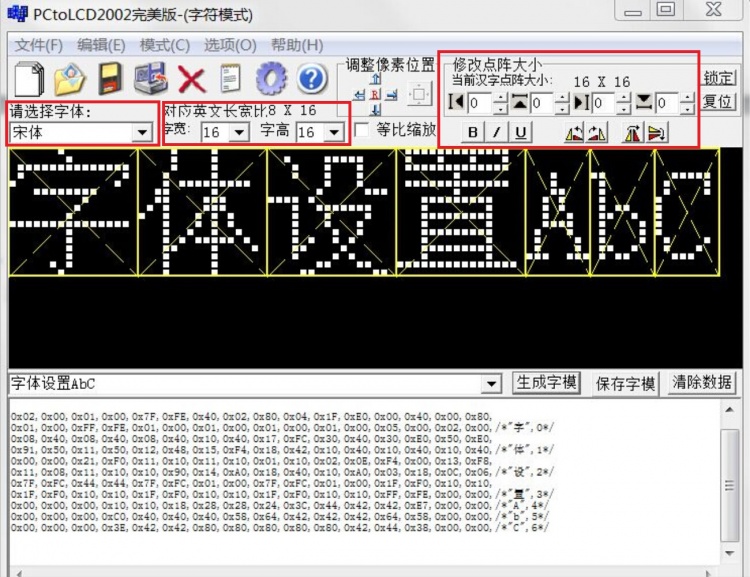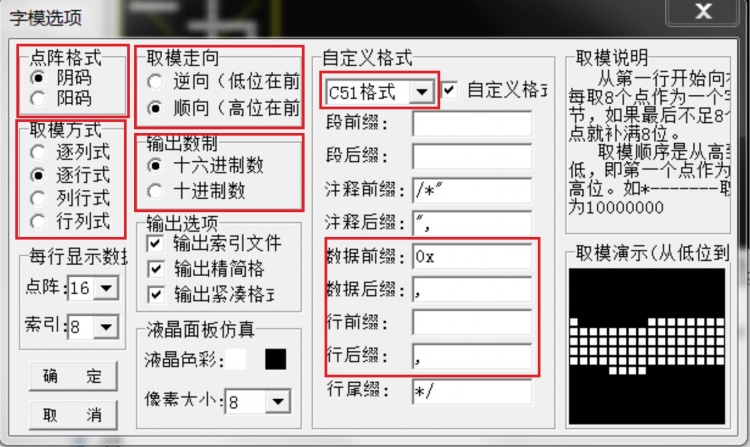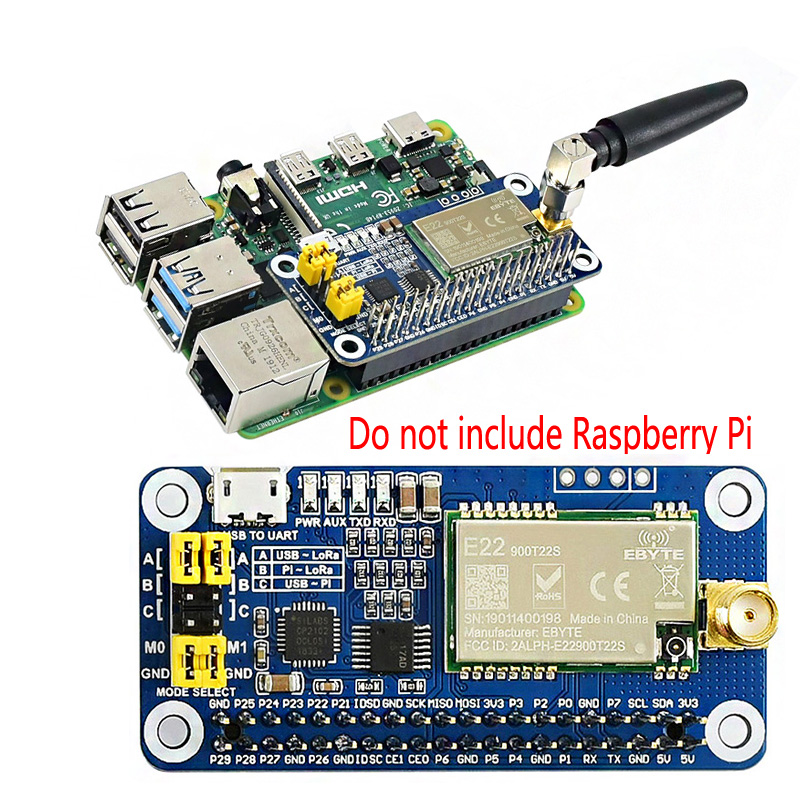- sales/support
Google Chat: zj734465502@gmail.com
- sales
+86-0755-88291180
- sales01
sales@spotpear.com
- sales02
dragon_manager@163.com
- support
tech-support@spotpear.com
- CEO-Complaints
zhoujie@spotpear.com
- sales/support
WhatsApp:13246739196
- HOME
- >
- ARTICLES
- >
- Common Moudle
- >
- LCD
Chinese and English display modulo settings
Molding software configuration
The font modulo software used in the test example is PCtoLCD2002. For detailed instructions on its use, see the following document:
PCtoLCD2002 Instructions for use
The PCtoLCD2002 software is specifically set as follows:
- Font and size selection

- Mode needs to select 字符模式
- Fonts can be selected according to needs, such as selection 宋体
- The word width and word height can be selected according to the needs. The font sizes commonly used in Chinese and English are as follows:
- Chinese (word width x word height):16x16、24x24、32x32、48x48
- English (character x word height):6x8、6x12、8x16、12x24、16x32、24x48(The corresponding font size needs to be set to respectively12x8、12x12、16x16、24x24、32x32、48x48)
- Modify the dot matrix size can be set according to requirements, generally set to 0
- Font option setting
- There are many situations in the Chinese and English font option setting. Different settings and different code processing methods.
- Here is an example of the following settings, the subsequent function code is written based on this setting.

- Dot matrix format select 阴码
- Modal mode select 逐行式
- Molding trend select 顺向(高位在前)
- Output number system select 十六进制数
- Custom format select C51格式
Bottom support function
- LCD_SetWindows
- The function implementation differs depending on the driver IC (different drive ICs set coordinate values with different commands and principles),
- but the principle is basically the same, setting the start and end coordinates and setting a display area.
- Examples are as follows (ILI9341 as an example)
void LCD_SetWindows(u16 xStar, u16 yStar,u16 xEnd,u16 yEnd)
{
LCD_WR_REG(lcddev.setxcmd);
LCD_WR_DATA(xStar>>8);
LCD_WR_DATA(0x00FF&xStar);
LCD_WR_DATA(xEnd>>8);
LCD_WR_DATA(0x00FF&xEnd);
LCD_WR_REG(lcddev.setycmd);
LCD_WR_DATA(yStar>>8);
LCD_WR_DATA(0x00FF&yStar);
LCD_WR_DATA(yEnd>>8);
LCD_WR_DATA(0x00FF&yEnd);
LCD_WriteRAM_Prepare(); //Start writing to GRAM
}
- Lcd_WriteData_16Bit
- This function is to set the pixel color value into GRAM, and then display it
- Examples are as follows (ILI9341 as an example)
void Lcd_WriteData_16Bit(u16 Data)
{
LCD_CS_CLR;
LCD_RS_SET;
SPI_WriteByte(SPI2,Data>>8);
SPI_WriteByte(SPI2,Data);
LCD_CS_SET;
}
- LCD_DrawPoint
- In fact, the LCD_SetWindows function and the Lcd_WriteData_16Bit function are used to display a pixel.
- Examples are as follows (ILI9341 as an example)
void LCD_DrawPoint(u16 x,u16 y)
{
LCD_SetCursor(x,y);//Set the cursor position
Lcd_WriteData_16Bit(POINT_COLOR);
}
English character modulo
- Important note
- 1.Because in the program, the English characters that need to be displayed are searched according to the ASCII offset,
- so the entire set of ASCII characters needs to be modeled.
- 2.If you do not need to use a character, you can set the modulo data of the character to {0},
- as shown in the following example (take 6x8 size characters as an example)
const unsigned char asc2_0806[95][8]={
... //This example is omitted, the actual application needs to be added
{0},/*"2",18*/ Do not use number 2
{0x00,0x00,0x78,0xB0,0x08,0x88,0x70,0x00},/*"3",19*/
{0x00,0x00,0x30,0x50,0x90,0x78,0x10,0x00},/*"4",20*/
{0},/*"5",21*/ Do not use number 5
{0x00,0x00,0x70,0x80,0xF8,0x88,0x70,0x00},/*"6",22*/
{0},/*"7",23*/ Do not use number 7
{0x00,0x00,0xF8,0x88,0x70,0x88,0x78,0x00},/*"8",24*/
{0},/*"9",25*/ Do not use number 9
... //This example is omitted, the actual application needs to be added
}
- 3.The ASCII characters are as follows (the first space is also included):
- ASCII characters: !"#$%&'()*+,-./0123456789:;<=>?@ABCDEFGHIJKLMNOPQRSTUVWXYZ[\]^_`abcdefghijklmnopqrstuvwxyz{|}~
- 4.The English modulo data fonts are all Default
- The different sizes of English character modulo description
Chinese character modulo
- Important note
- 1.When displaying Chinese characters, the modulo data is obtained by querying the GBK code that needs to display Chinese characters;
- 2.After the Chinese character is successfully modulo, the corresponding relationship between the Chinese character GBK code and the modulo data is saved through an array of structures.
- 3.The structure is defined as follows:
//16x16 Chinese font structure definition
typedef struct
{
unsigned char Index[2]; //Store Chinese character GBK code
char Msk[32]; //Store Chinese character modulo data
}typFNT_GB16; //Structure name can be defined by yourself
\\\\\\\\\\\\\\\\\\\\\\\\\\\\\\\\\\\\\\\\\\\\\\\\\\\\\\\\\\\\\\\\\\\\\\\\\
//24x24 Chinese font structure definition
typedef struct
{
unsigned char Index[2]; //Store Chinese character GBK code
char Msk[72]; //Store Chinese character modulo data
}typFNT_GB24; //Structure name can be defined by yourself
\\\\\\\\\\\\\\\\\\\\\\\\\\\\\\\\\\\\\\\\\\\\\\\\\\\\\\\\\\\\\\\\\\\\\\\\\
//32x32 Chinese font structure definition
typedef struct
{
unsigned char Index[2]; //Store Chinese character GBK code
char Msk[128]; //Store Chinese character modulo data
}typFNT_GB32; //Structure name can be defined by yourself
\\\\\\\\\\\\\\\\\\\\\\\\\\\\\\\\\\\\\\\\\\\\\\\\\\\\\\\\\\\\\\\\\\\\\\\\\
//48x48 Chinese font structure definition
typedef struct
{
unsigned char Index[2]; //Store Chinese character GBK code
char Msk[288]; //Store Chinese character modulo data
}typFNT_GB48; //Structure name can be defined by yourself
- The different sizes of Chinese modulo description
TAG:
Raspberry Pi 3D Display
Raspberry Pi AF Camera
IR Thermal Imaging Camera
JETSON NANO MINI Fan
Jetson Orin Nano/NX Super Developer IO Base Development Board Dual network RJ45 For Jetson Orin Nano/NX Module
Intel 12th
UART To Ethernet
Raspberry Pi 10.1 inch LCD HDM Display Capacitive TouchScreen 10.1EP-CAPLCD 1920x1200 For Jetson Nano/mini Computer PC
Raspberry Pi display
Step Recording and Reproduction
Raspberry Pi 5 Case
ESP32 C3 ST7735
luckfox-pico-ultra-w-gpio Use
PC Monitor LCD
Raspberry Pi 5 IR Camera
Raspberry Pi 5 RTC charge configuration
OLED-LCD-HAT-A user guide
Raspberry Pi Pico 1.54inch LCD display 240×240 IPS 1.54 inch screen
ESP32-C6
ESP32 S3 Development Board 1.5 inch Round Rotary OLED TouchScreen Smart Knob Display 1.5inch Display 466x466 LVGL for Arduino
TAG:
Raspberry Pi 10.1 inch DSI LCD TouchScreen Display 800x1280 RK3576 RK3506 ESP32-P4 Luckfox Lyra
RV1103 SC3336
LuckFox
Raspberry Pi 12.3 inch DSI MIPI Display TouchScreen LCD 720x1920 Luckfox Lyra Omni3576 RK3576
Raspberry Pi 5 PCIe M.2 5G 4G 3G SIM8262A-M2
Raspberry Pi Power Relay Board
Raspberry Pi Compute Module 5 CM5 Official Original IO Board
USB Monitor Display
Raspberry Pi 5 PCIe to M.2 Multi Function Adapter Board Supports Dual 4K HDMI Output
ESP32 Thermal imaging
SpotPear
Raspberry Pi RP2040 LoRa
ESP32 C3
Raspberry Pi AI Camera 12MP IMX500 RP2040
CVITEK CV1800B SG2000 SG2002 64MB 256MB 512MB RISC-V DRAM-64M Chip
ESP32-S3 5inch LCD
DeepSeek AI Voice Chat ESP32 S3 Development Board 1.83 inch TouchScreen Display 240x284
ESP32
2.13Inch E-Paper
RP2040 0.85inch LCD




